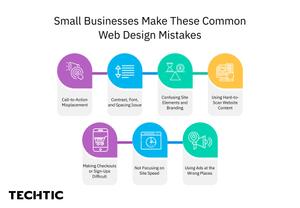7 Most Common Web Design Mistakes Small Businesses Make
Sector: UI/UX
Author: Nisarg Mehta
Date Published: 04/05/2014

An unpleasant website drives away customers and can cost businesses a lot of money. Unfortunately, this occurs all too frequently.
Small business owners, in an effort to save money and have more control over the project, often design their own websites. This results in a website that is less than ideal because most business owners don’t understand the basics of good web design.
At its core, web design is an art form. Just like art, web design seeks to provide its viewers with an experience. Web design combines form and function to make a website enjoyable, navigable, interesting, and usable. Web designers must follow certain ‘unspoken’ and spoken rules in order to accomplish this.
But not everyone knows the best web design practices and, hence, tends to make mistakes. Following are the most common web design mistakes small businesses make.
Common Web Design Mistakes You Should Avoid

1. Call-to-Action Misplacement
Your CTA is the gateway to sales. It instructs your visitors, i.e., click here, gets a coupon, or learn more about this product. However, your CTA must clearly inform your customers what to do.
Visitors should know what they will receive in exchange for taking action and what information they will need to provide. On the other hand, being helpful yet irritating is a fine line. Make sure your CTA is short and clear so that customers know exactly what to do. Don’t overload customers with form-filling, and offer them a few minutes to browse your page before displaying the CTA.
2. Contrast, Font, and Spacing Issue
Many people, including designers, make the error of not using contrast in web design. For example, light gray might look nice in your color scheme, but it’s too difficult to read. Businesses should realize that website accessibility is an important issue.
Also, the font you select and how content is laid out on your web page is vitally important. Customers learn about your business and its offerings by reading your content.
Hence, it is crucial to pay careful attention to font choice and presentation on your page. At the same time, typeface and fonts convey your brand image in addition to the words you write, so pick an eye-catching and legible font.
Moreover, white space assists in drawing the eye throughout the website and making large blocks of text less intimidating. Many people inadvertently overload their websites with text. You may break up text wherever possible and represent ideas visually rather than textually if possible.
3. Confusing Site Elements and Branding
This web design mistake is the extension of the last one, but very common and critical to avoid.
The “confused brand” website is positioned somewhere between overuse and underuse. Using multiple typefaces, colors, images, and themes that don’t work together are considered confusing.
There are numerous reasons for this. It might be because you don’t have a clear brand message. When you like several template designs and want to use them all, you might accidentally create a confusing site. It might also happen when you attempt to express a lot of ideas at once and see your website as a collection of independent parts rather than a whole.
However, it’s important to keep one theme, one logo, and one typeface throughout your website.
4. Using Hard-to-Scan Website Content
Website visitors don’t read in the same way they read books. Instead of reading every word, visitors scan to locate the data they desire.
Many businesses make the mistake of stuffing in a lot of content within their web pages. There are many reasons for this, but the most common one is SEO. Marketers tend to believe that the more content the better the rank on the search engine results page. However, it isn’t the case in reality. Content length isn’t among the top ranking factors for website service pages.
Instead, you should use headlines, bullet points, and pictures to make your content easy to scan and emphasize the most critical points. Google, for example, reads headlines before paragraphs, so having keyword-rich headlines will also help your search engine ranking.
5. Making Checkouts or Sign-Ups Difficult
You might’ve encountered long and complex sign-up forms at some point in time. It was difficult for you to fill in too much information (even if they’re necessary), and you didn’t pass through it. The same goes for your website visitors.
Many businesses often make the mistake of asking for unnecessary information (i.e., personal info, project details, addresses, etc.) from their website visitors. This hampers the user experience and reduces website conversions.
The goal is to minimize barriers to conversion while ensuring that visitors grasp what they are getting. You can offer sign-up options via popular social platforms or Google or Apple ID. Also, provide just enough information to motivate people to move forward, but not so much that they are overwhelmed.
For example, your service/product page should include the same CTA in several locations, which then links to the next phase (checkout, etc.). You don’t want people to have to travel through numerous pages just to add something to their cart or schedule a call with you.
6. Not Focusing on Site Speed
Site speed is vitally important to both website visitors and search engine rankings. Web Pages that are sluggish to load are just abandoned, and if your website loads slowly, people will go elsewhere.
We encounter too many websites that are aesthetically good but take minutes to load, which feels like years.
Even many experienced web designers make this mistake. The most common argument is “it’s loading perfectly on my system.” However, the focus should be on site performance in low internet bandwidth scenarios.
You may use Google’s PageSpeed Insights to gauge your website’s performance. Minify CSS, use optimized photos and use the least amount of Javascript and custom fonts possible if your website loads slowly.
7. Using Ads at the Wrong Places
There is no arguing the fact that ads are an important part of web design. However, you must be cautious not to overdo it, as too many ads or invasive advertisements will irritate your visitors and result in lost revenue.
You should inspect your advertisements as carefully as a bird; if you are irritated by them even slightly, your visitors will be as well. Pay careful attention to pop-ups; while they are generally becoming popular again, make sure they are easy to close and do not open up full-screen.
Every phase of the design process should be weighed against the target audience and brand image. Your website will speak volumes about your business if you can successfully integrate the two.
Avoid These Web Designing Mistakes for Better Outcomes
Despite the fact that avoiding these seven common mistakes in website design won’t guarantee that your website is well designed, it will turn a decent website into a fantastic one.
Whenever you can provide better service to your website visitors and ideal clients by making your website accessible, you’re demonstrating your expertise and how much you care about all the individuals who come to your website or examine your products.
If you lack expertise in web designing, we’d recommend you to consult experts like us. Techtic has been helping businesses with UI/UX and front end development. Our team is dextrous with most front-end and web technologies.







